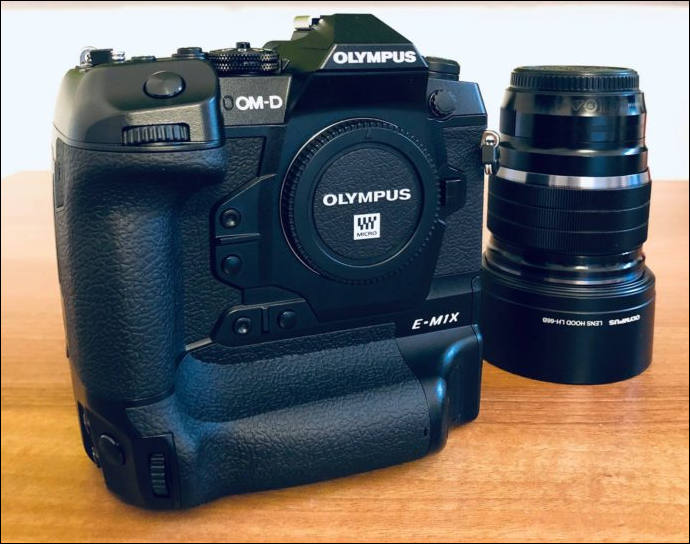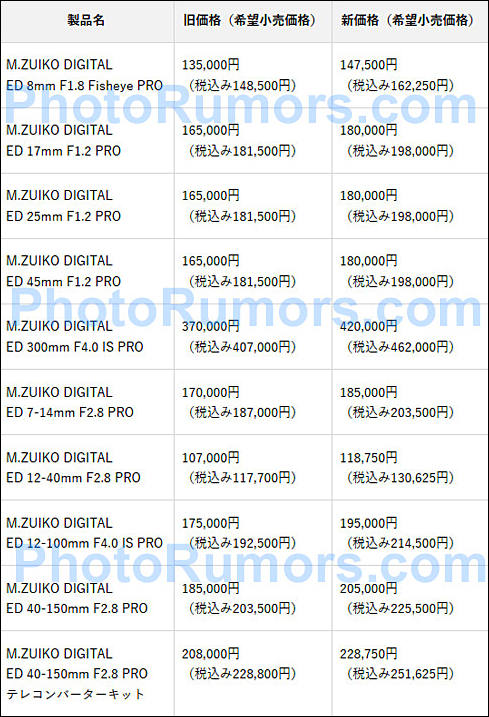
-

- 20MP Four Thirds sensor
- 121-point autofocus system with deep learning-based subject recognition
- Hand-held high-res shot mode
- Up to 60 fps Raw + JPEG capture (up to 18 fps with autofocus)
- Pro Capture mode records frames before you hit the shutter
- Up 7.5EV of image stabilization with supported lenses
- 'Live ND' multi-shot mode simulates ND filters
- Large 2.36M-dot LCD viewfinder able to work at up to 120fps
- Dual BLH-1 batteries giving 870 shots per charge (CIPA)
- Dual UHS-II SD memory card slots
- Extensive direct control, dual AF joysticks, articulating touchscreen
- UHD 4K/30p video and DCI 24p at up to 237Mbps
- Extensive, IPX1-rated weather sealing
- USB charging
- Effective Resolution 20.4 megapixels
- Continuous Shooting Speed 18 fps
- 50 MP Handheld High Res shot functionality. Building on the HiRes innovation on the E-M1 MK II where a tripod was required, the E-M1X can now take a 50mp HiRes shot handheld. Using a tripod it can now produce 80mp images.
- World's best Image stabilization: In combination with a M.Zuiko IS PRO lens, this technology enables the 5-axis sync IS to compensate for approx. 7.5 shutter speed steps.
- Totally new AF system with various AF target modes and settings and intelligent subject tracking.
- With locked AF, the E-M1X features high-speed sequential shooting at a maximum of 60 fps to capture split-second moments that the human eye cannot see. With AF/AE tracking, a maximum of 18 fps may be reached.
- Key OM-D Movie video capabilities: 4K and C4K, OM-Log400, Different levels of IS, 120 fps high-speed shooting in Full HD
- Anti-flicker shooting capabilities
- Live ND feature for slow shutter effects without an external filter.
- Dust, splash, & freezeproof. Weatherproofing maintained even when connecting microphone, earphone or remote control cable
- Integrated field sensors to add detailed metadata to pictures and video
- Two UHS-II SD card slots for high-speed responsiveness
- Two batteries in innovative cartridge system and USB charging capabilities
- The sensor dust reduction system now features an improved Super Sonic Wave Filter (SSWF) with a special coating which vibrates 30,000 times per second further reducing the possibility of dust or dirt ruining photos and equipment by factor 10
- Capture up to 2,580 images before having to recharge. Featuring USB Power Delivery (USB-PD) from up to 100 W power sources, both batteries in the camera body can be fully charged in approximately two hours
- A new Wi-Fi capture allows tethered shooting without a cable and makes it possible to transfer images wirelessly to a computer with the Olympus
- Weight 997g
- Body (WxHxD) 144.4 x 146.8 x 75.4mm
- Price for body is ¥365,040 or £2,799, available April
Available for $2999 at
- US - https://www.amazon.com/Olympus-E-M1X-OM-D/dp/B07MKPNS7D/
- US - https://www.adorama.com/iomem1x.html
- US - https://www.bhphotovideo.com/c/product/1450952-REG/olympus_v201080bu000_om_d_e_m1x_mirrorless_micro.html
- UK -https://www.wexphotovideo.com/olympus-om-d-e-m1x-digital-camera-body-1687525/
- DE - https://www.calumetphoto.de/product/Olympus-OM-D-E-M1X-Gehause-schwarz/OLYOMDEM1X
-
Wanting to see Olympus put an Aps-C sensor in this body. Full frame would of course be glorious, but I think honestly they could steel the show, and even increase sales of the Micro four thirds version by doing this as there would be many hipsters touting how comfortable and just right this body feels in the hand. APS-C version could be $4000 and compete with full frame counter parts based on stabilization and specs.
-
On sale for 1699USD at B&H. I still hold this in my hand every time I visit my local shop. It's sorta like therapy, and a reminder what a camera should feel like in the hand.
-
FIRMWARE DEVELOPMENT FOR RAW VIDEO DATA OUTPUT
Olympus is pleased to announce development for firmware that enables output of RAW video data from the Olympus OM-D E-M1X and Olympus OM-D E-M1 Mark III mirrorless cameras to the ATOMOS NINJA V HDR monitor recorder. Data will be recorded to the ATOMOS NINJA V as Apple ProRes RAW for flexible image editing. This lends greater flexibility to professional video production post-processing tasks, such as adjusting exposure and color grading recorded footage. The firmware is being developed in collaboration with ATOMOS and is scheduled for release in Winter 2020.
Olympus will continue to support professional video production via hand-held high-definition video recording with their compact lightweight system, thanks to its unrivaled portability and powerful in-body 5-Axis Image Stabilization with 5-Axis Sync IS capabilities.
-
Saw the 2K price, it's a great deal on an amazing camera that never got its proper dues.. 80MP images! Now with raw video output right!?
-
Price is set to $1999, further cut to $1399-1499 can happen as last batches will be selling
- https://www.bhphotovideo.com/c/product/1450952-REG/olympus_v201080bu000_om_d_e_m1x_mirrorless_micro.html
- https://www.amazon.com/Olympus-E-M1X-OM-D/dp/B07MKPNS7D/
New owner will be closing production of most bodies till 2021.
-
Atomos is excited to announce co-development with Olympus of RAW recording over HDMI with the OM-D E-M1X and Olympus OM-D E-M1 Mark III mirrorless cameras. Together these powerful Olympus cameras and the Atomos Ninja V will record Apple ProRes RAW directly from the camera’s sensor.
Olympus users who love the OM-D family for its portability and in-body 5-axis image stabilization will get all the benefits of a ProRes RAW workflow – creative control to adjust the color and look of the video in post-production while extending brightness and shadow detail.
The Ninja V allows users to accurately monitor the RAW signal on its daylight-viewable 5” 1000nit brightness HDR screen. Setup is simple with perfectly tuned color settings applied automatically. Users can then view the image in HDR quality with a choice of HLG and PQ (HDR10) formats. The Ninja V offers touchscreen access to tools like waveforms, 1-1 magnification and focus peaking, allowing users to perfect their shot setup. The Ninja V then records the ProRes RAW data onto a removable AtomX SSDmini or other SSD drive. When shooting is complete the drive is removed and connected to a computer via USB for immediate offload and editing.
Jeromy Young, Atomos CEO, said: “We’re thrilled to work with Olympus and their stunning mirrorless cameras to bring the power of Apple’s ProRes RAW to OM-D users. We can’t wait to see the creativity that results from this partnership”.
ProRes RAW the new standard:
ProRes RAW is now firmly established as the new standard for RAW video capture, with Olympus being the eighth brand to support the format with the OM-D E-M1X and OM-D E-M1 Mark III mirrorless cameras. ProRes RAW combines the visual and workflow benefits of RAW video with the incredible real-time performance of ProRes. The format gives filmmakers enormous latitude when adjusting the look of their images and extending brightness and shadow detail, making it ideal for HDR workflows. Both ProRes RAW, and the higher bandwidth, less compressed ProRes RAW HQ are supported. Manageable file sizes speed up and simplify file transfer, media management, and archiving. ProRes RAW is fully supported in Final Cut Pro X and Adobe Premiere Pro along with a collection of other apps including ASSIMILATE SCRATCH, Colorfront, FilmLight Baselight and Grass Valley Edius.
The firmware update to enable these features is scheduled for winter 2020.
Rumors are that it was idea of new managers who saw big piles of unsold bodies and hope that addition of external raw will allow to sell them.
-
Olympus will soon release a new major firmware update.
Lets just hope they will ahve anyone able to develop such :-)
Big major cuts in Olympus Japanese camera part are rumored to start in June.
-
When combined with the M.Zuiko Digital ED 12-100m f/4.0 IS PRO lens, the E-M1X can provide image stabilization performance of 7.5 steps, which – as of the beginning of 2019 – is the highest level in the world.
According to our own in-house performance evaluation, this system can maintain a stable image was stable even at a shutter speed of 4 seconds and using a focal length of 40mm (equivalent to 80mm on a 35mm camera).
This is an improvement of 1 step over the stabilization effect provided by the combination of the same lens with the E-M1 Mark II. Among the factors making this possible are the development of a new gyro sensor and the design of several algorithms to maximize stabilization performance.
We have long been a leader in image stabilization technology, but in order to take that cutting edge performance to the next level we needed to develop a gyro with performance equivalent to an optical fiber gyro. Optical fiber gyros are so precise that they are used in aircraft and launch vehicles. They are also big and expensive. Our goal was to implement that kind of performance in a small sensor comparable in size to our previous models. This was no easy task, but finally, after three years of joint development with a parts manufacturer, we succeeded.
The new sensor isn’t just a step up to a new level of performance, it enters a whole new dimension. So powerful was this new gyro, that we found it nearly impossible to update our algorithms to take advantage of its performance. To succeed, we had to go through a long process of trials and errors.
The new gyro sensor isn’t just a step up to a new level of performance, it enters a whole new dimension. So powerful was this new gyro, that we found it nearly impossible to update our algorithms to take advantage of its performance. To succeed, we had to go through a long process of trials and errors.
The first problem we encountered was the impossibility of accurate evaluation. As the gyro sensor cannot be accurately evaluated in a building with a quake-absorbing structure, we had to build a lab specifically for this purpose. However, even when we executed measurements in accordance with the optimum evaluation technique, our results still varied with every measurement. Eventually we realized that accurate measurement was not possible at the current level of technology and that we would need dedicated equipment and a more difficult environment in order to properly evaluate this new gyro sensor.
There was also a surprise in the camera manufacturing process. Assembly of the image stabilizer has always been an extremely difficult process that imposed a burden on the operator. We found that some cameras were unable to manifest the expected performance even when they were precisely assembled by skilled operators.
What this meant was that the gyro sensor performance and the target image stabilization performance were so vastly improved that issues previously regarded to be inconsequential suddenly loomed large. To deal with the emergence of these new problems, we had to revamp the manufacturing process itself.
Ultimately, our goal is to eliminate the need for a tripod altogether and make it possible for photographers to enjoy handheld shooting in any scene under any conditions.
-
10 per cent price hike coming to Olympus Pro lenses in 2020.

https://photorumors.com/2019/12/01/olympus-lens-price-increase-coming-in-february-2020/

 sa11356.jpg489 x 717 - 109K
sa11356.jpg489 x 717 - 109K -
How is your professional strategy evolving now that the E-M1X exists?
The E-M1X has completely changed our position in the professional market. We see a lot of changes. The E-M1X is designed for wildlife, birding and sports. After we announced the 150-400mm we had a lot of enquiries and questions from those people, and we've had a lot of requests for pre-orders even though we haven't yet revealed pricing information.
The reason is the size and weight, and also the other characteristics of our system. Very strong stabilization, and now the ability to capture very fast-moving subjects.
How many E-M1X buyers were already invested in your system, versus completely new users? That's hard to say. At the very beginning it was mostly Olympus users, but recently we had a 'trade in, trade up' promotion, and it's about half and half, people trading from our own system versus new users coming in from other [brands]. A lot of people from the wildlife and sports fields are coming into our system.
Do you have a target in terms of market share?
We don't have specific numbers, but in terms of birding and wildlife we have targets for the number of users. But we don't know how big the market is.
When you talk to E-M1X users, do you find that they use that camera for one kind of photography, and another camera or another brand for a different kind of photography?
We are seeing a trend with people coming from full-frame, where they need a small camera for travel, they use Olympus. We call those people 'switchers'. But after we introduced the E-M1X, we have seen people working in the birding and wildlife field, they're starting to switch. They don't even test the gear sometimes, they just switch completely.
-
Olympus OM-D E-M1X Mirrorless Digital Camera (Body Only) deal, for $2599
-

 sa10220.jpg791 x 591 - 43K
sa10220.jpg791 x 591 - 43K -

 sa9717.jpg794 x 528 - 61K
sa9717.jpg794 x 528 - 61K -
Olympus E-M1X Field Test

https://www.imaging-resource.com/PRODS/olympus-e-m1x/olympus-e-m1xA.HTM#shooting3

 sa9684.jpg800 x 596 - 140K
sa9684.jpg800 x 596 - 140K
Howdy, Stranger!
It looks like you're new here. If you want to get involved, click one of these buttons!
Categories
- Topics List23,991
- Blog5,725
- General and News1,353
- Hacks and Patches1,153
- ↳ Top Settings33
- ↳ Beginners256
- ↳ Archives402
- ↳ Hacks News and Development56
- Cameras2,367
- ↳ Panasonic995
- ↳ Canon118
- ↳ Sony156
- ↳ Nikon96
- ↳ Pentax and Samsung70
- ↳ Olympus and Fujifilm101
- ↳ Compacts and Camcorders300
- ↳ Smartphones for video97
- ↳ Pro Video Cameras191
- ↳ BlackMagic and other raw cameras116
- Skill1,960
- ↳ Business and distribution66
- ↳ Preparation, scripts and legal38
- ↳ Art149
- ↳ Import, Convert, Exporting291
- ↳ Editors191
- ↳ Effects and stunts115
- ↳ Color grading197
- ↳ Sound and Music280
- ↳ Lighting96
- ↳ Software and storage tips266
- Gear5,420
- ↳ Filters, Adapters, Matte boxes344
- ↳ Lenses1,582
- ↳ Follow focus and gears93
- ↳ Sound499
- ↳ Lighting gear314
- ↳ Camera movement230
- ↳ Gimbals and copters302
- ↳ Rigs and related stuff273
- ↳ Power solutions83
- ↳ Monitors and viewfinders340
- ↳ Tripods and fluid heads139
- ↳ Storage286
- ↳ Computers and studio gear560
- ↳ VR and 3D248
- Showcase1,859
- Marketplace2,834
- Offtopic1,320








